DEM Simulation of a Rotary Drum with Inclined Flights Using the Response Surface Methodology
Abstract
1. Introduction
2. Method and Simulation
2.1. DEM Model
2.2. Simulation Conditions
3. Results and Discussions
3.1. Trajectory of a Single Bead Moving in the Drum
3.2. Individual Factor Effects
3.3. Interactive Effects
3.4. Influence of the Inclined Angles
4. Conclusions
Author Contributions
Funding
Data Availability Statement
Conflicts of Interest
Nomenclature
| List of symbols | |
| e | coefficient of restitution (−) |
| F | force [N] |
| g | gravity [m s−2] |
| G | shear modulus [Pa] |
| G* | equivalent shear modulus [Pa] |
| I | moment of inertia [m s−2] |
| k | elastic constant [kg m−2] |
| M | rolling friction torque [N m−1] |
| m | particle mass [kg] |
| m* | equivalent mass [kg] |
| R | radius [m] |
| R* | radius [m] |
| S | stiffness [Pa m] |
| T | tangential torque [N m−1] |
| Y | Young′s modulus [Pa] |
| Y* | equivalent Young′s modulus [Pa] |
| Greek symbols | |
| α | joint angle of the two-segment flights [°] |
| β | inclined angle between flights and wall [°] |
| η | Poisson’s ratio [−] |
| δ | overlap distance of two particles [m] |
| γ | viscoelastic damping constant [−] |
| μx | coefficient static friction |
| v | particle velocity [m/s] |
| ω | rotational speed [rpm] |
| Indices | |
| i and j | particle identification index |
| n | normal direction |
| t | tangential direction |
References
- Trojosky, M. Rotary drums for efficient drying and cooling. Dry. Technol. 2019, 37, 632–651. [Google Scholar] [CrossRef]
- Yang, S.; Sun, Y.; Chew, J.W. Simulation of the granular flow of cylindrical particles in the rotating drum. AIChE J. 2018, 64, 3835–3848. [Google Scholar] [CrossRef]
- Yazdani, E.; Hashemabadi, S.H. DEM simulation of heat transfer of binary-sized particles in a horizontal rotating drum. Granul. Matter 2018, 21, 6. [Google Scholar] [CrossRef]
- Sunkara, K.R.; Herz, F.; Specht, E.; Mellmann, J. Transverse flow at the flight surface in flighted rotary drum. Powder Technol. 2015, 275, 161–171. [Google Scholar] [CrossRef]
- Lee, A.; Sheehan, M.E. Development of a geometric flight unloading model for flighted rotary dryers. Powder Technol. 2010, 198, 395–403. [Google Scholar] [CrossRef]
- Sunkara, K.R.; Herz, F.; Specht, E.; Mellmann, J. Influence of flight design on the particle distribution of a flighted rotating drum. Chem. Eng. Sci. 2013, 90, 101–109. [Google Scholar] [CrossRef]
- Heilbuth, R.R.; Souza, G.M.; Santos, D.A.; Brandao, R.J.; Barrozo, M.A.S.; Duarte, C.R. Numerical evaluation of the granular mixing behavior in a flighted rotary drum through the Discrete Element Method. Powder Technol. 2022, 400, 117251. [Google Scholar] [CrossRef]
- Piton, M.; Huchet, F.; Le Corre, O.; Le Guen, L.; Cazacliu, B. A coupled thermal-granular model in flights rotary kiln: Industrial validation and process design. Appl. Therm. Eng. 2015, 75, 1011–1021. [Google Scholar] [CrossRef]
- Xie, Q.; Chen, Z.; Hou, Q.; Yu, A.B.; Yang, R. DEM investigation of heat transfer in a drum mixer with lifters. Powder Technol. 2017, 314, 175–181. [Google Scholar] [CrossRef]
- Seidenbecher, J.; Herz, F.; Sunkara, K.R.; Mellmann, J. Modelling the final discharge angle in flighted rotary drums. Granul. Matter 2022, 24, 123. [Google Scholar] [CrossRef]
- Nascimento, S.M.; Lima, R.M.; Brandão, R.J.; Duarte, C.R.; Barrozo, M.A.S. Eulerian study of flights discharge in a rotating drum. Can. J. Chem. Eng. 2019, 97, 477–484. [Google Scholar] [CrossRef]
- Geng, F.; Li, Y.; Wang, X.; Yuan, Z.; Yan, Y.; Luo, D. Simulation of dynamic processes on flexible filamentous particles in the transverse section of a rotary dryer and its comparison with ideo-imaging experiments. Powder Technol. 2011, 207, 175–182. [Google Scholar] [CrossRef]
- Pan, J.P.; Wang, T.-J.; Yao, J.-J.; Jin, Y. Granule transport and mean residence time in horizontal drum with inclined flights. Powder Technol. 2006, 162, 50–58. [Google Scholar] [CrossRef]
- Karali, M.A.; Sunkara, K.R.; Herz, F.; Specht, E. Experimental analysis of a flighted rotary drum to assess the optimum loading. Chem. Eng. Sci. 2015, 138, 772–779. [Google Scholar] [CrossRef]
- Seidenbecher, J.; Herz, F.; Meitzner, C.; Specht, E.; Wirtz, S.; Scherer, V.; Liu, X. Experimental analysis of the flight design effect on the temperature distribution in rotary kilns. Chem. Eng. Sci. 2021, 240, 116652. [Google Scholar] [CrossRef]
- Bongo Njeng, A.S.; Vitu, S.; Clausse, M.; Dirion, J.L.; Debacq, M. Effect of lifter shape and operating parameters on the flow of materials in a pilot rotary kiln: Part II. Experimental hold-up and mean residence time modeling. Powder Technol. 2015, 269, 566–576. [Google Scholar] [CrossRef]
- Yang, S.; Cahyadi, A.; Wang, J.; Chew, J.W. DEM study of granular flow characteristics in the active and passive regions of a three-dimensional rotating drum. AIChE J. 2016, 62, 3874–3888. [Google Scholar] [CrossRef]
- Yu, M.; Zhang, H.; Guo, J.; Zhang, J.; Han, Y. Three-dimensional DEM simulation of polydisperse particle flow in rolling mode rotating drum. Powder Technol. 2022, 396, 626–636. [Google Scholar] [CrossRef]
- Yazdani, E.; Hassan Hashemabadi, S. Three-dimensional heat transfer in a particulate bed in a rotary drum studied via the discrete element method. Particuology 2020, 51, 155–162. [Google Scholar] [CrossRef]
- Zhang, L.; Jiang, Z.; Mellmann, J.; Weigler, F.; Herz, F.; Bück, A.; Tsotsas, E. Influence of the number of flights on the dilute phase ratio in flighted rotating drums by PTV measurements and DEM simulations. Particuology 2021, 56, 171–182. [Google Scholar] [CrossRef]
- Silveira, J.C.; Lima, R.M.; Brandao, R.J.; Duarte, C.R.; Barrozo, M.A.S. A study of the design and arrangement of flights in a rotary drum. Powder Technol. 2022, 395, 195–206. [Google Scholar] [CrossRef]
- Bongo Njeng, A.S.; Vitu, S.; Clausse, M.; Dirion, J.L.; Debacq, M. Effect of lifter shape and operating parameters on the flow of materials in a pilot rotary kiln: Part I. Experimental RTD and axial dispersion study. Powder Technol. 2015, 269, 554–565. [Google Scholar] [CrossRef]
- Xie, L.; Yang, L.; Su, L.; Xu, S.; Zhang, W. A Novel Rotary Dryer Filled with Alumina Ceramic Beads for the Treatment of Industrial Wastewaters: Numerical Simulation and Experimental Study. Processes 2021, 9, 862. [Google Scholar] [CrossRef]
- Xie, L.X.; Xu, S.C.; Su, L.B.; Cao, C.P.; Du, H.X.; Yang, L.L. A High Efficiency and Energy Saving Evaporative Drying Device. Chinese Patent CN211310913U, 21 August 2020. [Google Scholar]
- Zuo, Z.; Gong, S.; Xie, G.; Zhang, J. Sensitivity analysis of process parameters for granular mixing in an intensive mixer using response surface methodology. Powder Technol. 2021, 384, 51–61. [Google Scholar] [CrossRef]
- Rong, W.; Feng, Y.; Schwarz, P.; Yurata, T.; Witt, P.; Li, B.; Song, T.; Zhou, J. Sensitivity analysis of particle contact parameters for DEM simulation in a rotating drum using response surface methodology. Powder Technol. 2020, 362, 604–614. [Google Scholar] [CrossRef]
- Karatza, Z.; Andò, E.; Papanicolopulos, S.A.; Viggiani, G.; Ooi, J.Y. Effect of particle morphology and contacts on particle breakage in a granular assembly studied using X-ray tomography. Granul. Matter 2019, 21, 44. [Google Scholar] [CrossRef]
- Yin, Z.Y.; Wang, P.; Zhang, F. Effect of particle shape on the progressive failure of shield tunnel face in granular soils by coupled FDM-DEM method. Tunn. Undergr. Space Technol. 2020, 100, 103394. [Google Scholar] [CrossRef]
- Wang, P.; Yin, Z.Y.; Wang, Z.Y. Micromechanical Investigation of Particle-Size Effect of Granular Materials in Biaxial Test with the Role of Particle Breakage. J. Eng. Mech. 2022, 148, 04021133. [Google Scholar] [CrossRef]
- Yang, X.; Long, L.H.; Matthew, T. Effect of particle shape on stress-dilatancy responses of medium-dense sands. J. Geotech. Geoenvironmental Eng. 2019, 145, 04018105. [Google Scholar]
- Cundall, P.A.; Strack, O.D.L. A discrete numerical model for granular assemblies. Géotechnique 1979, 29, 47–65. [Google Scholar] [CrossRef]
- Silveira, J.C.; Brandao, R.J.; Lima, R.M.; Machado, M.V.C.; Barrozo, M.A.S.; Duarte, C.R. A fluid dynamic study of the active phase behavior in a rotary drum with flights of two and three segments. Powder Technol. 2020, 368, 297–307. [Google Scholar] [CrossRef]
- Stevens, A.B.; Hrenya, C.M. Comparison of soft-sphere models to measurements of collision properties during normal impacts. Powder Technol. 2005, 154, 99–109. [Google Scholar] [CrossRef]
- Ma, H.; Zhao, Y. Modelling of the flow of ellipsoidal particles in a horizontal rotating drum based on DEM simulation. Chem. Eng. Sci. 2017, 172, 636–651. [Google Scholar] [CrossRef]
- Santos, D.A.; Dadalto, F.O.; Scatena, R.; Duarte, C.R.; Barrozo, M.A.S. A hydrodynamic analysis of a rotating drum operating in the rolling regime. Chem. Eng. Res. Des. 2015, 94, 204–212. [Google Scholar] [CrossRef]
- Zheng, X.; Jin, B.; Zhang, Y.; Zhang, Y.; Zhou, C. Numerical Simulation of Flow Characteristics in an Inclining Rotating Kiln with Continuous Feeding. Int. J. Chem. React. Eng. 2019, 17. [Google Scholar] [CrossRef]
- Chen, L.J.; Sun, Z.J.; Zhang, Y. Energy loss caused by the elbow of stiff shotcrete pneumatic conveying based on response surface method and CFD-DEM. Powder Technol. 2022, 408, 117726. [Google Scholar] [CrossRef]
- Luo, D. Optimization of total polysaccharide extraction from Dioscorea nipponica Makino using response surface methodology and uniform design. Carbohydr. Polym. 2012, 90, 284–288. [Google Scholar] [CrossRef]
- Shasha, H.U.; Yihong, W.; Chengming, W.; Moucheng, W.U. Optimization of Extraction Process of Water-soluble Polysaccharides from Seeds of Pistacia chinensis Bung by Response Surface Methodology. Food Sci. 2008, 29, 172–176. [Google Scholar]
- Murthy, M.S.R.C.; Swaminathan, T.; Rakshit, S.K. Statistical optimization of lipase catalyzed hydrolysis of methyloleate by response surface methodology. Bioprocess Eng. 2000, 22, 35–39. [Google Scholar] [CrossRef]
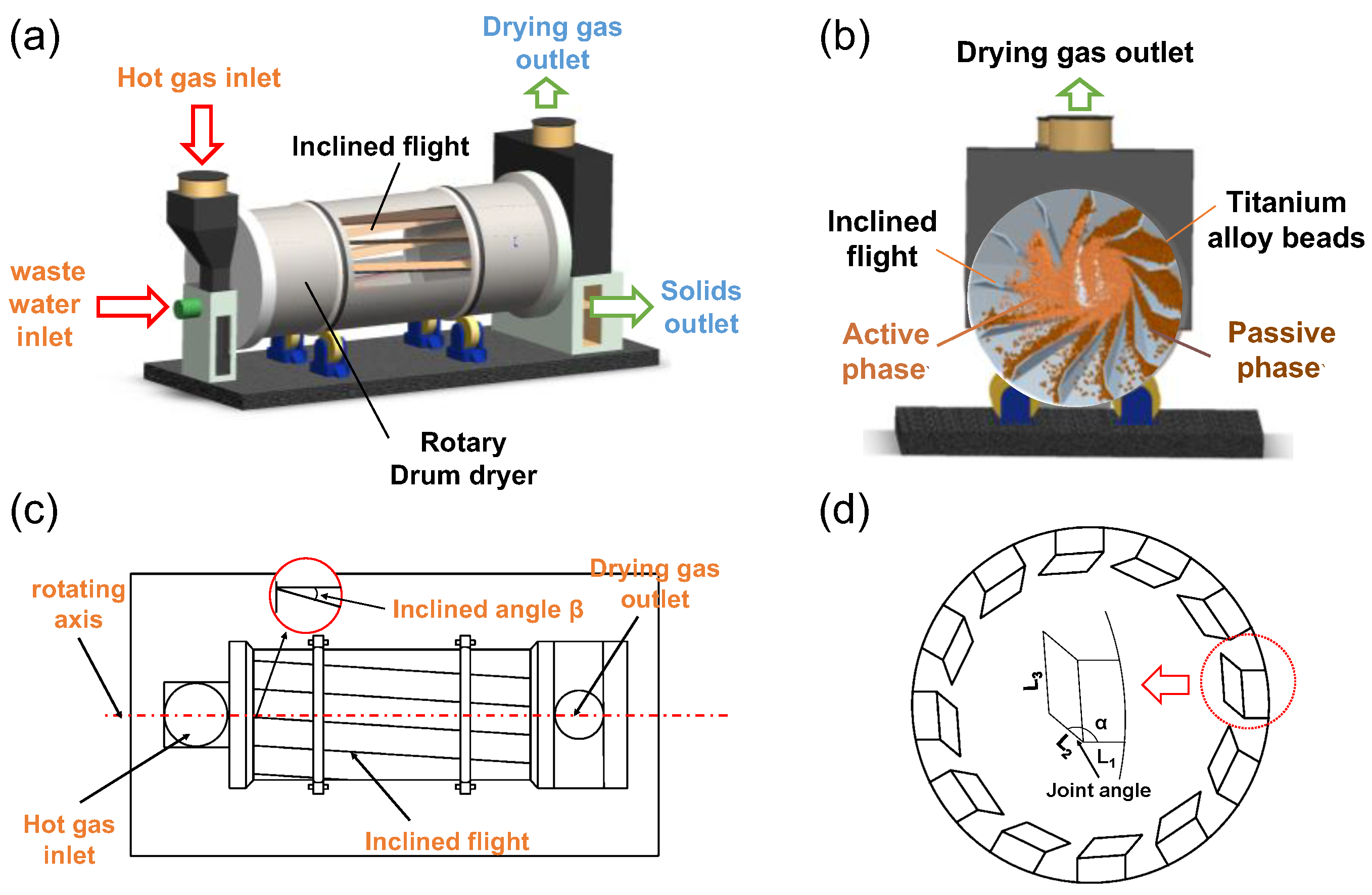
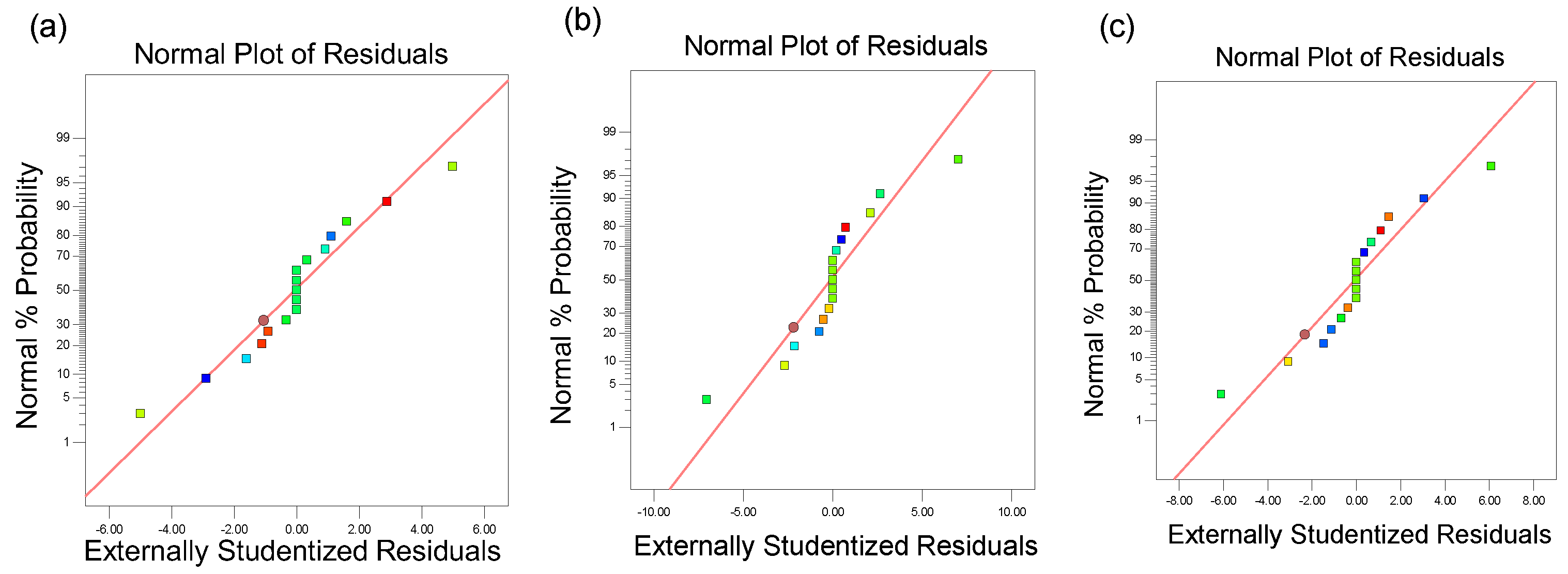


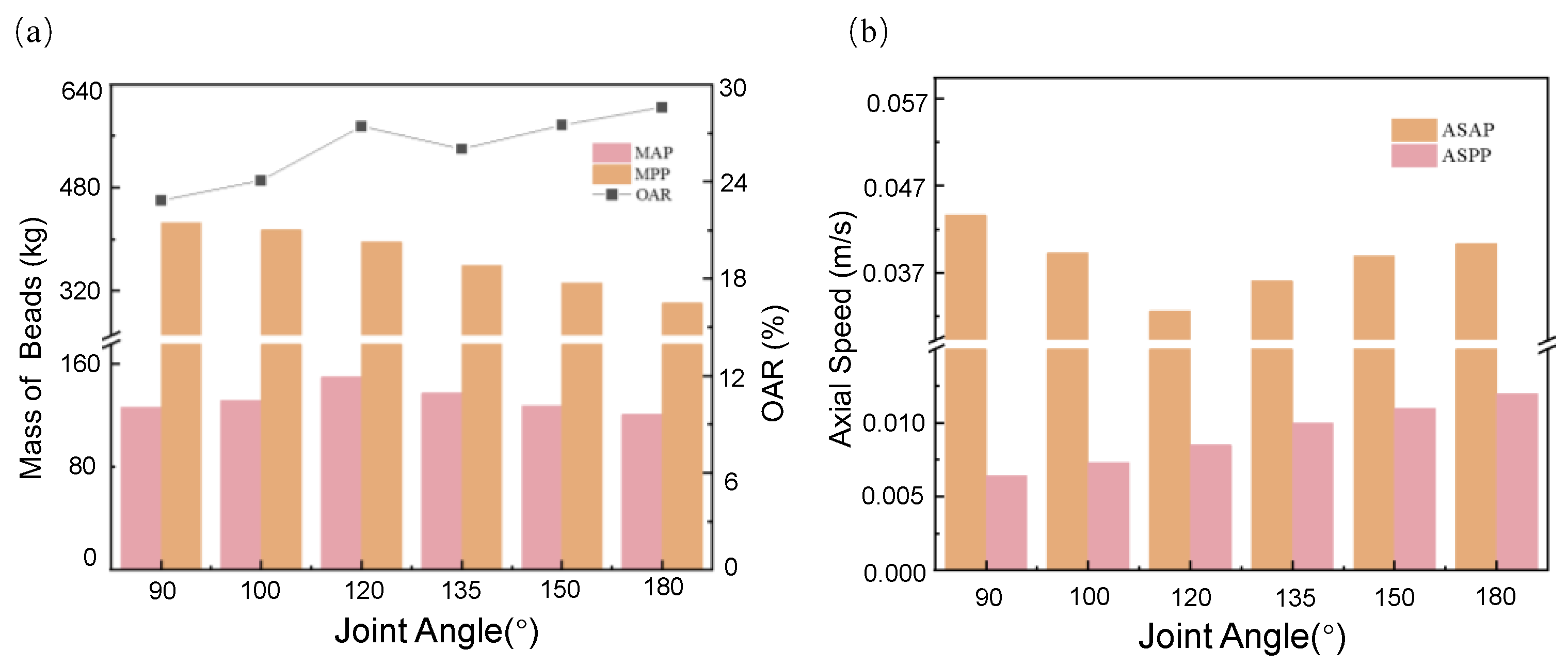
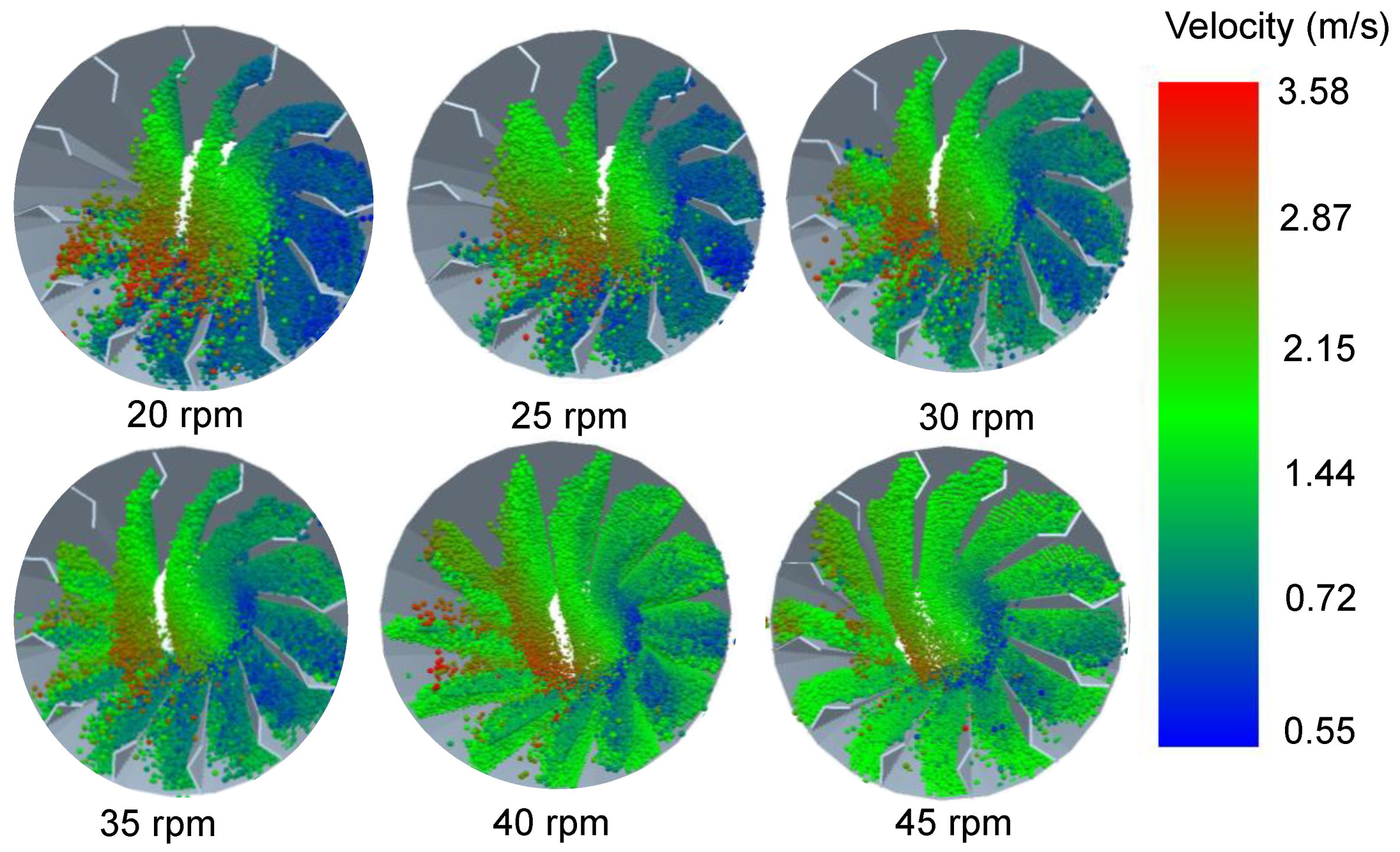
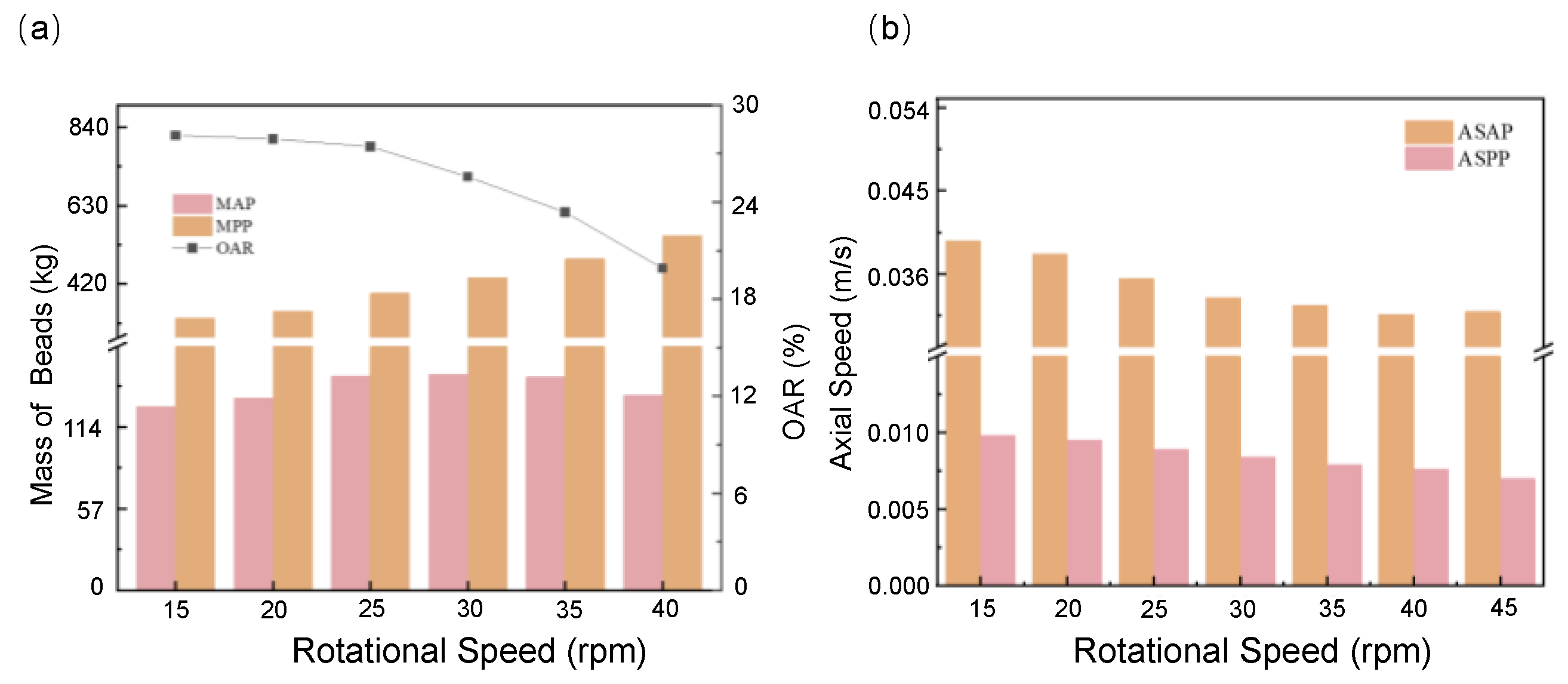
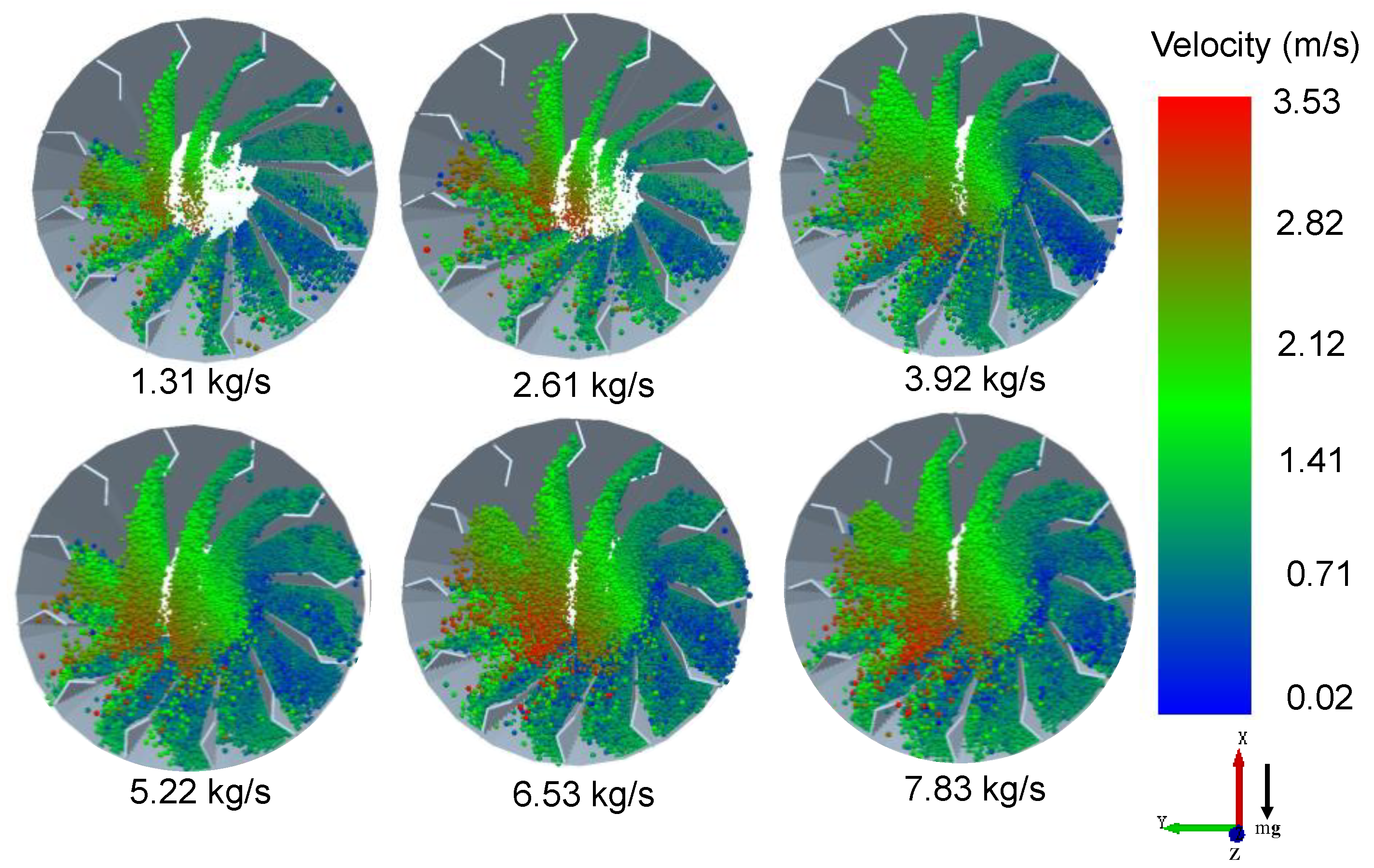
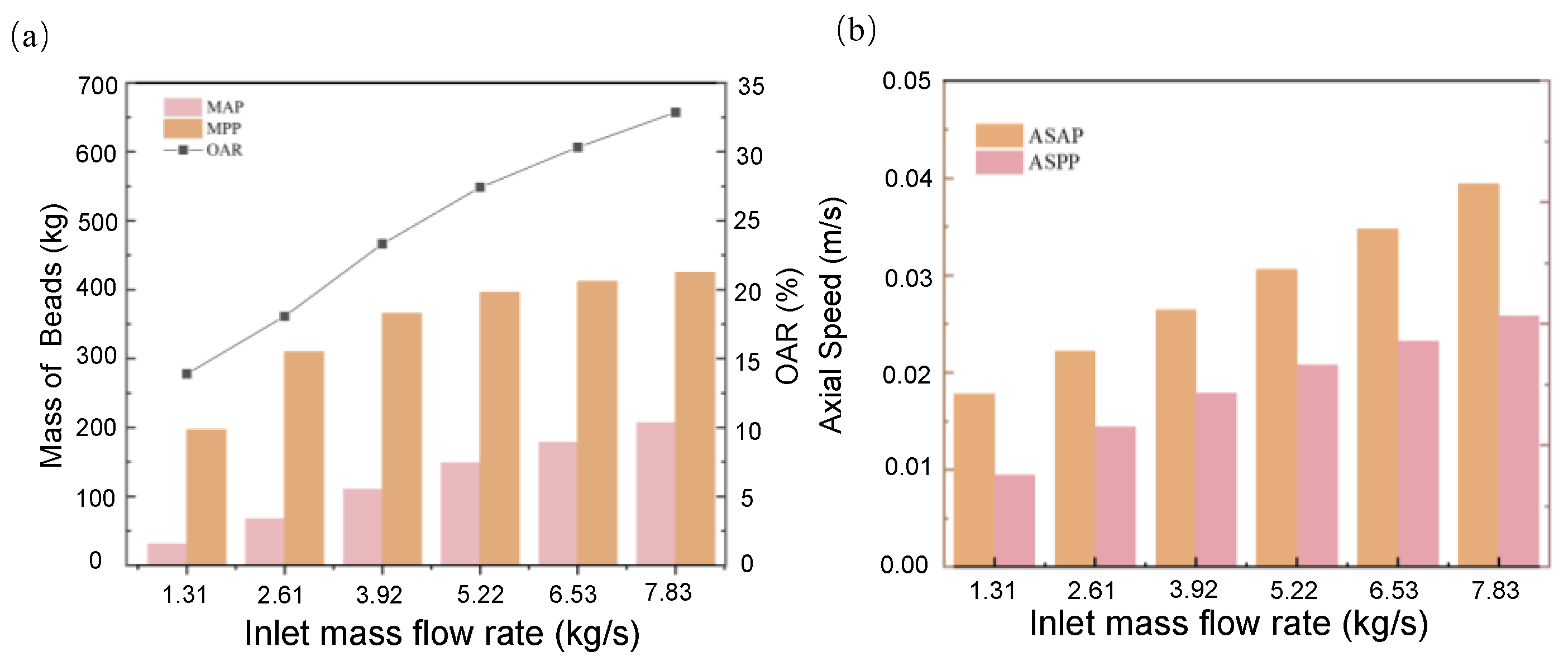
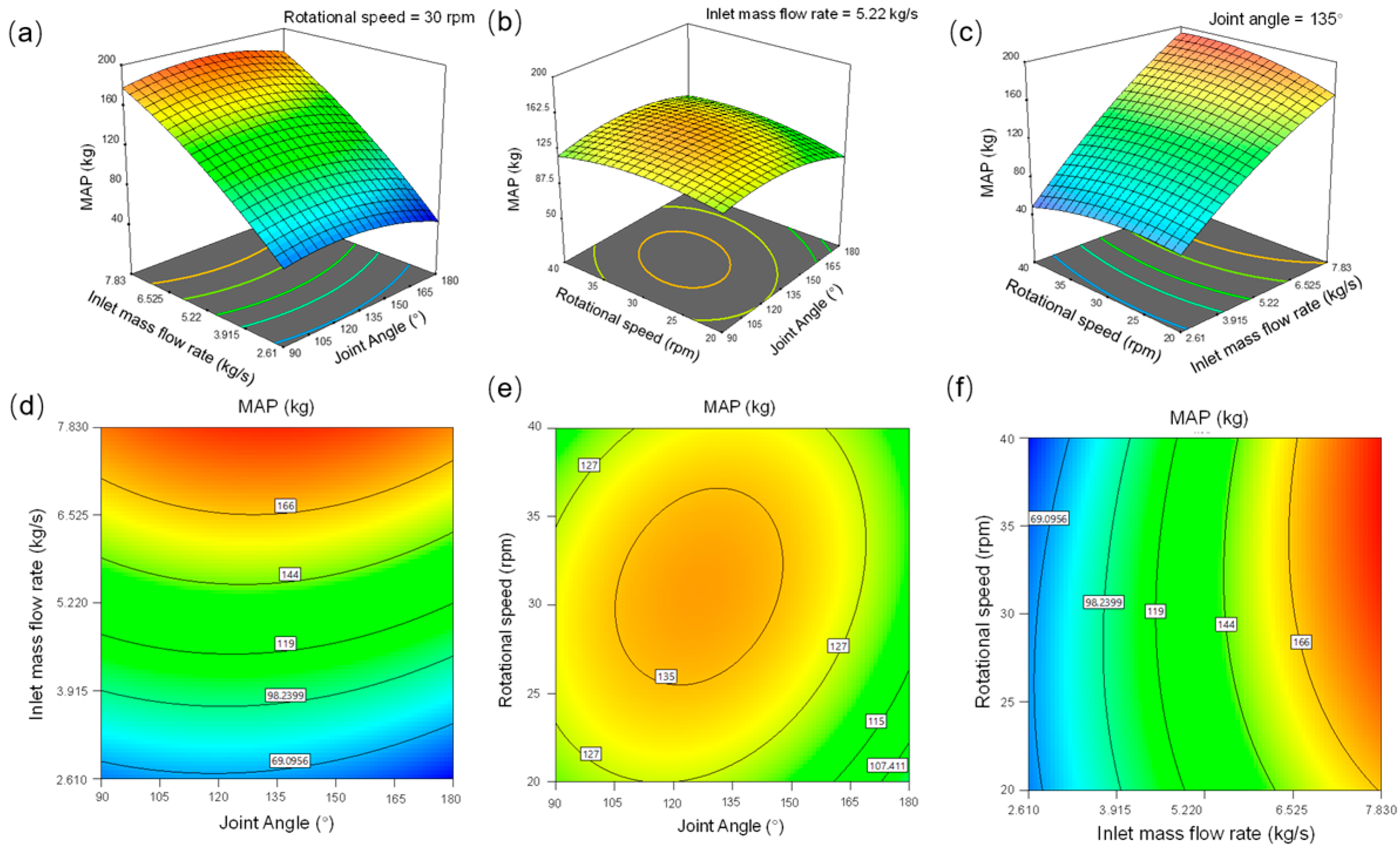
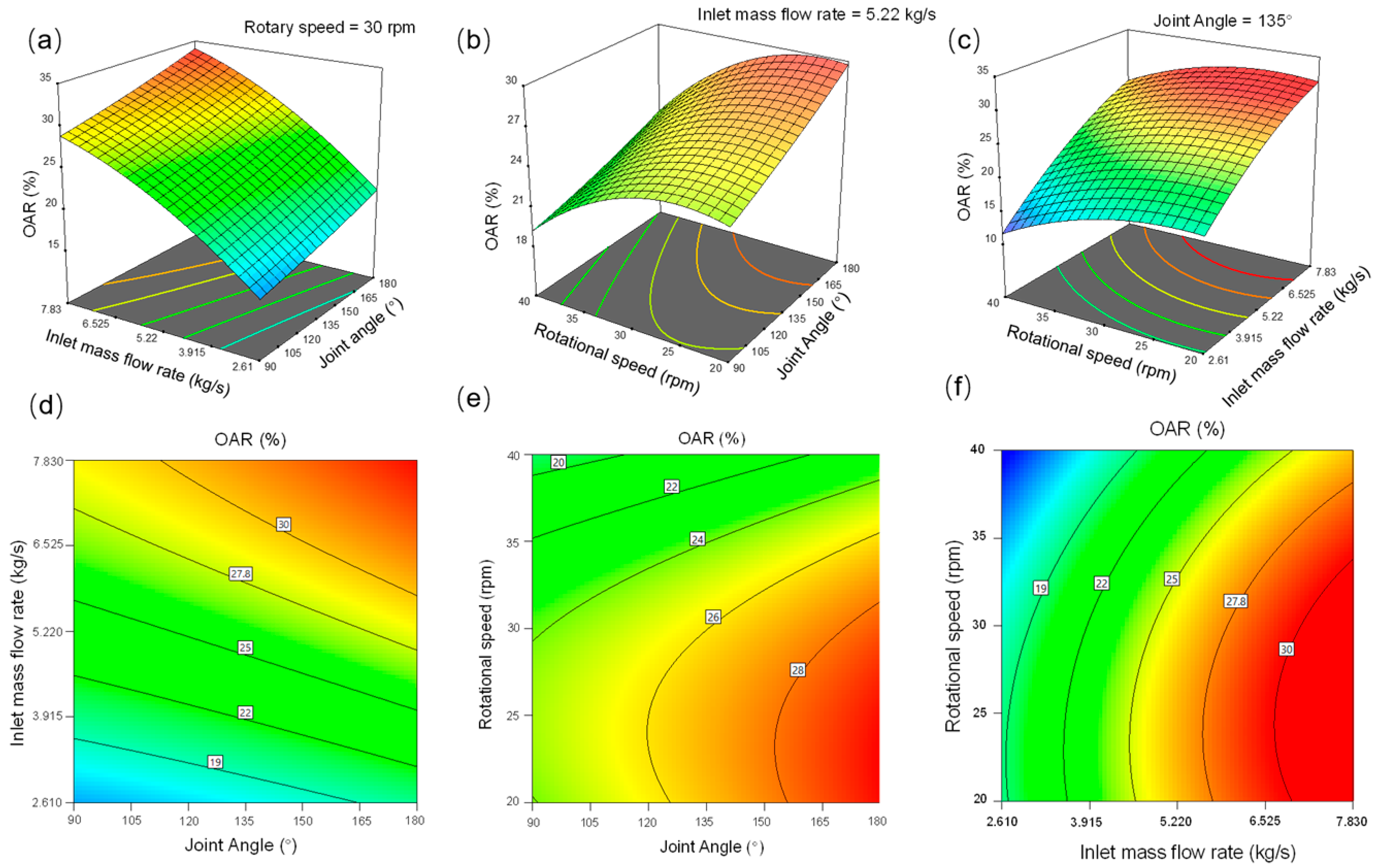
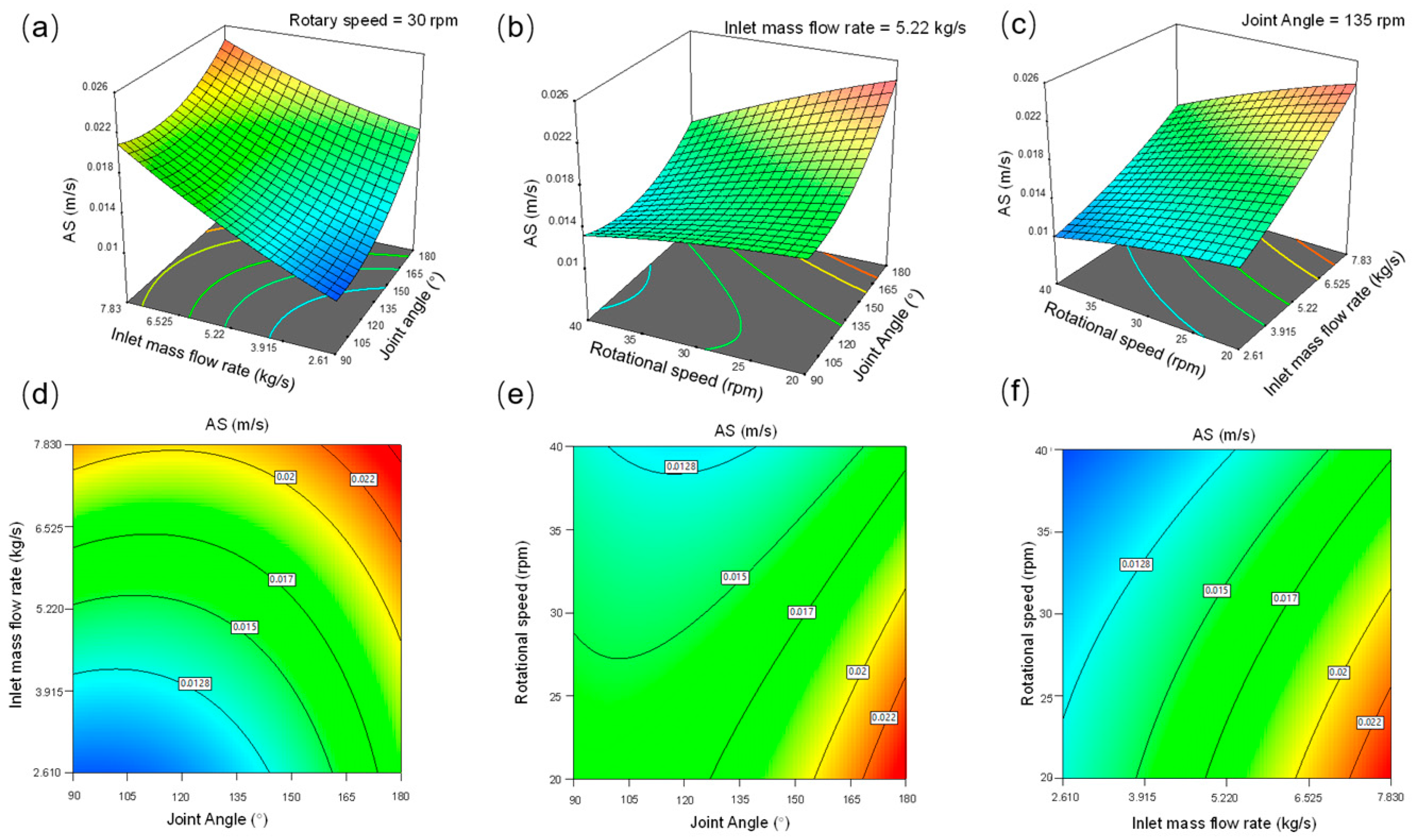
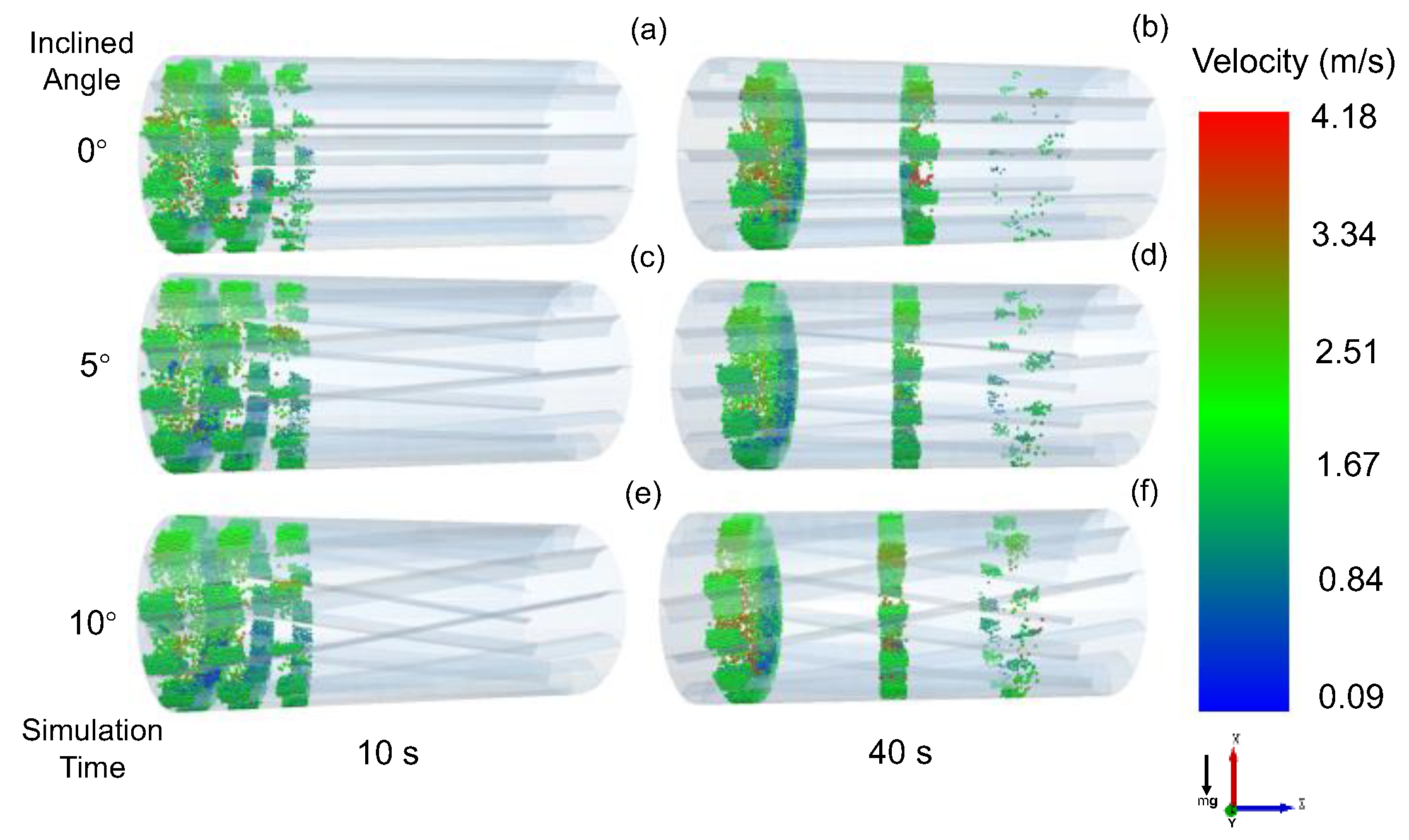
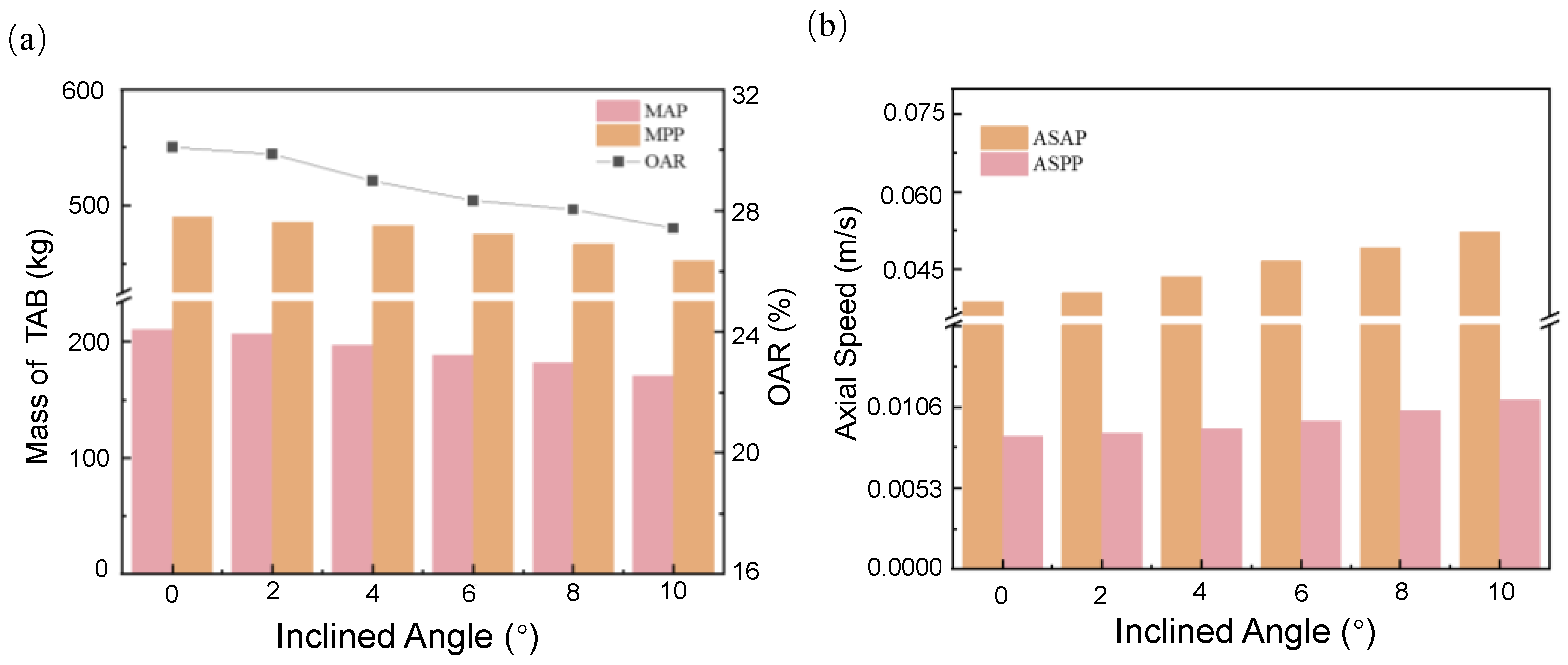
| Properties | Value |
|---|---|
| Density of particle, ρ (kg/m3) | 4540 |
| Young′s modulus, Y (Pa) | 1.2 × 108 |
| Poisson’s ratio, η (−) | 0.32 |
| Restitution coefficient (particle/particle), epp (−) | 0.2 |
| Restitution coefficient (particle/wall), epw (−) | 0.9 |
| Coefficient static friction (particle/particle), μs,pp (−) | 0.54 |
| Coefficient static friction (particle/wall), μs,pw (−) | 0.5 |
| Drum diameter × Length, D × L (mm × mm) | 800 × 1700 |
| Number of flights (−) | 12 |
| Flights thickness, FT (mm) | 6 |
| Particle diameter, Dp (mm) | 13 |
| Parameters | Joint Angle (°) | Inlet Flow Rate (kg/s) | Rotational Speed (rpm) |
|---|---|---|---|
| Low level | 90 | 2.61 | 20 |
| Middle level | 135 | 5.22 | 30 |
| High level | 180 | 7.83 | 40 |
| Run | Joint Angle (°) | Mass Flow Rate (kg/s) | Rotational Speed (rpm) | MAP (kg) | OAR (%) | AS (m/s) |
|---|---|---|---|---|---|---|
| 1 | 90 | 2.61 | 30 | 58.10 | 15.13 | 0.0107 |
| 2 | 90 | 7.83 | 30 | 176.93 | 28.00 | 0.0198 |
| 3 | 90 | 5.22 | 40 | 116.61 | 19.31 | 0.0138 |
| 4 | 90 | 5.22 | 20 | 128.78 | 25.08 | 0.0159 |
| 5 | 135 | 5.22 | 30 | 137.05 | 25.98 | 0.0155 |
| 6 | 135 | 2.61 | 40 | 53.40 | 11.95 | 0.0089 |
| 7 | 135 | 5.22 | 30 | 137.05 | 25.98 | 0.0155 |
| 8 | 135 | 7.83 | 40 | 196.01 | 27.44 | 0.0175 |
| 9 | 135 | 7.83 | 20 | 161.40 | 31.00 | 0.0247 |
| 10 | 135 | 5.22 | 30 | 137.05 | 25.98 | 0.0155 |
| 11 | 135 | 5.22 | 30 | 137.05 | 25.98 | 0.0155 |
| 12 | 135 | 5.22 | 30 | 137.05 | 25.98 | 0.0155 |
| 13 | 135 | 2.61 | 20 | 60.68 | 17.85 | 0.0124 |
| 14 | 180 | 5.22 | 20 | 111.50 | 21.75 | 0.0162 |
| 15 | 180 | 7.83 | 40 | 178.40 | 34.36 | 0.0239 |
| 16 | 180 | 2.61 | 30 | 44.12 | 20.79 | 0.0194 |
| 17 | 180 | 5.22 | 30 | 103.80 | 29.65 | 0.0236 |
| Response | Fit Model | Source | Sum of Squares | df | Mean Squares | F-Value | p-Value |
|---|---|---|---|---|---|---|---|
| MAP | Quadratic | Model | 33,314.69 | 9 | 3701.63 | 146.40 | <0.0001 |
| A-A | 226.85 | 1 | 226.85 | 8.97 | 0.0201 | ||
| B-B | 30,806.58 | 1 | 30,806.58 | 1218.39 | <0.0001 | ||
| C-C | 65.32 | 1 | 65.32 | 2.58 | 0.1520 | ||
| AB | 59.68 | 1 | 59.68 | 2.36 | 0.1684 | ||
| AC | 98.70 | 1 | 98.70 | 3.90 | 0.0887 | ||
| BC | 438.69 | 1 | 438.69 | 17.35 | 0.0042 | ||
| A2 | 677.11 | 1 | 677.11 | 26.78 | 0.0013 | ||
| B2 | 419.48 | 1 | 419.48 | 16.59 | 0.0047 | ||
| C2 | 356.09 | 1 | 356.09 | 14.08 | 0.0071 | ||
| Residual | 176.99 | 7 | 25.28 | ||||
| Cor Total | 33,491.68 | 16 | |||||
| OAR | Quadratic | Model | 528.92 | 9 | 58.77 | 69.05 | <0.0001 |
| A-A | 45.27 | 1 | 45.27 | 53.18 | 0.0002 | ||
| B-B | 379.23 | 1 | 379.23 | 445.55 | <0.0001 | ||
| C-C | 66.87 | 1 | 66.87 | 78.57 | <0.0001 | ||
| AB | 0.12 | 1 | 0.12 | 0.14 | 0.7157 | ||
| AC | 1.13 | 1 | 1.13 | 1.33 | 0.2862 | ||
| BC | 1.37 | 1 | 1.37 | 1.61 | 0.2453 | ||
| A2 | 0.24 | 1 | 0.24 | 0.28 | 0.6118 | ||
| B2 | 11.45 | 1 | 11.45 | 13.45 | 0.0080 | ||
| C2 | 21.72 | 1 | 21.72 | 25.52 | 0.0015 | ||
| Residual | 5.96 | 7 | 0.85 | ||||
| Cor Total | 534.88 | 16 | |||||
| AS | Quadratic | Model | 3.05 × 10−4 | 9 | 3.39 × 10−5 | 30.61 | <0.0001 |
| A-A | 6.56 × 10−5 | 1 | 6.56 × 10−5 | 59.19 | 0.0001 | ||
| B-B | 1.49 × 10−4 | 1 | 1.49 × 10−4 | 134.34 | <0.0001 | ||
| C-C | 5.10 × 10−5 | 1 | 5.10 × 10−5 | 46.05 | 0.0003 | ||
| AB | 5.29 × 10−6 | 1 | 5.29 × 10−6 | 4.78 | 0.0651 | ||
| AC | 7.02 × 10−6 | 1 | 7.02 × 10−6 | 6.34 | 0.0399 | ||
| BC | 3.42 × 10−6 | 1 | 3.42 × 10−6 | 3.09 | 0.1222 | ||
| A2 | 2.08 × 10−5 | 1 | 2.08 × 10−5 | 18.82 | 0.0034 | ||
| B2 | 2.21 × 10−6 | 1 | 2.21 × 10−6 | 2.00 | 0.2004 | ||
| C2 | 5.16 × 10−7 | 1 | 5.16 × 10−7 | 0.47 | 0.5169 | ||
| Residual | 7.75 × 10−6 | 7 | 1.11 × 10−6 | ||||
| Cor Total | 3.13 × 10−4 | 16 |
Disclaimer/Publisher’s Note: The statements, opinions and data contained in all publications are solely those of the individual author(s) and contributor(s) and not of MDPI and/or the editor(s). MDPI and/or the editor(s) disclaim responsibility for any injury to people or property resulting from any ideas, methods, instructions or products referred to in the content. |
© 2023 by the authors. Licensee MDPI, Basel, Switzerland. This article is an open access article distributed under the terms and conditions of the Creative Commons Attribution (CC BY) license (https://creativecommons.org/licenses/by/4.0/).
Share and Cite
Zhu, X.; Xie, L.; Xu, S.; Zhang, W. DEM Simulation of a Rotary Drum with Inclined Flights Using the Response Surface Methodology. Processes 2023, 11, 1363. https://doi.org/10.3390/pr11051363
Zhu X, Xie L, Xu S, Zhang W. DEM Simulation of a Rotary Drum with Inclined Flights Using the Response Surface Methodology. Processes. 2023; 11(5):1363. https://doi.org/10.3390/pr11051363
Chicago/Turabian StyleZhu, Xu, Lixin Xie, Shichang Xu, and Wen Zhang. 2023. "DEM Simulation of a Rotary Drum with Inclined Flights Using the Response Surface Methodology" Processes 11, no. 5: 1363. https://doi.org/10.3390/pr11051363
APA StyleZhu, X., Xie, L., Xu, S., & Zhang, W. (2023). DEM Simulation of a Rotary Drum with Inclined Flights Using the Response Surface Methodology. Processes, 11(5), 1363. https://doi.org/10.3390/pr11051363







